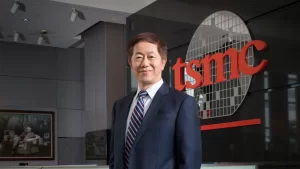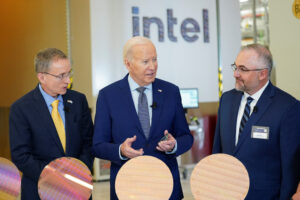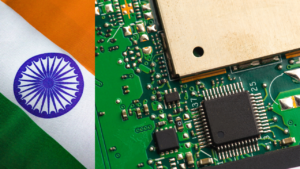Introduction
In a significant move in the semiconductor industry, Intel has announced its agreement to sell approximately 10% of its subsidiary, IMS Nanofabrication, to Taiwanese semiconductor foundry giant TSMC (Taiwan Semiconductor Manufacturing Company).
This transaction values IMS Nanofabrication at a substantial $4.3 billion. This $4.3 billion valuation aligns with the previous valuation when Intel sold around 20% of the subsidiary to private equity firm Bain Capital in June.
Background: IMS Nanofabrication and Its Role
Intel acquired IMS Nanofabrication, based in Vienna, Austria, in 2015. The company specializes in developing multi-beam masking tools, which are essential for the production of advanced extreme ultraviolet lithography (EUV) technology.
This technology allows for the production of smaller and more powerful semiconductor components, contributing to the ongoing advancements in the tech world.
Read more: Intel foundry is doomed to Fail: TSMC Director
TSMC’s Investment and Its Significance
TSMC’s decision to invest in IMS Nanofabrication signifies the importance of EUV technology in chip manufacturing. Companies like Intel and TSMC are increasingly adopting EUV technology for their advanced chip production. This is the reason why investments made by both TSMC and Bain Capital are expected to enhance IMS Nanofabrication’s independence. This move aims to bolster confidence in the subsidiary’s potential for growth and innovation in the future.
Read more: Why Intel’s Stock is Soaring Despite Issues
Intel’s Strategic Position
Intel’s role in this strategic maneuver is Interesting. While the company is in the process of establishing Intel Foundry Services, a contract chip manufacturing business aimed at competing with companies like TSMC, at the same time it is also reliant on TSMC for manufacturing a growing portion of its products.
This dual strategy, known as IDM 2.0 (Integrated Device Manufacturer), illustrates Intel’s adaptability and willingness to collaborate with industry leaders to ensure its continued presence in the highly competitive semiconductor market.
Intel exiting 8th business in last 2 years
Here are the 7 businesses that Intel has exited under CEO Pat Gelsinger:
Intel Optane. This was a memory and storage technology that Intel developed in partnership with Micron Technology. Intel discontinued the Optane business in July 2022, citing slow sales and competition from other technologies.
Intel Data Center Solutions Group. This was a division of Intel that developed and sold server chips and other products for data centers. Intel sold the division to Tower Semiconductor in January 2023.
Intel Sports. This was a division of Intel that developed and sold technology for live sports broadcasting. Intel shut down the division in August 2021.
WWAN Connected PC Business. This was a division of Intel that developed and sold 4G LTE and 5G modems for PCs. Intel exited the business in March 2023.
Drone Solutions Group. This was a division of Intel that developed and sold drone technology. Intel shut down the division in December 2022.
Network Switch Chip Business. This was a division of Intel that developed and sold network switch chips. Intel announced in January 2023 that it would end future investments in the business.
Cryptocurrency Mining Products. Intel developed a line of chips specifically designed for cryptocurrency mining. But the company discontinued the products in January 2023, citing environmental concerns.
The decision to exit these businesses was part of a larger strategic shift by Intel under Gelsinger. Gelsinger has focused on making Intel a more focused and competitive chipmaker, and he has said that he wants to invest in the company’s core businesses, such as its PC and server chips.
Moving forward, it remains to be seen whether Gelsinger’s strategy will be successful.
Industry Collaboration for Technological Advancement
The investment in IMS Nanofabrication by TSMC highlights the deep industry collaboration required to advance critical lithography technology for leading-edge semiconductor nodes.
Matt Poirier, Senior Vice President of Corporate Development at Intel, emphasized the significance of this collaboration in enhancing IMS’s independence and positioning the subsidiary to capture opportunities in the multi-beam mask writing tools market over the next decade and beyond.
Intel will retain the majority ownership of IMS, ensuring that the subsidiary continues to function independently, with CEO Elmar Platzgummer at the helm.
Long-Term Partnership and Cross-Industry Collaboration
Kevin Zhang, Senior Vice President of Business Development at TSMC, noted that the investment builds upon the long-standing partnership between TSMC and IMS, which dates back to 2012.
This investment is expected to accelerate innovation and foster deeper cross-industry collaboration. Such partnerships are crucial in driving technological advancements and ensuring that the semiconductor industry remains at the forefront of innovation.
Conclusion
Intel’s decision to sell a 10% stake in IMS Nanofabrication to TSMC underscores the evolving dynamics of the semiconductor industry. It showcases the importance of collaboration, independence, and strategic positioning in an industry where technological advancements are driving competition. The continued development of EUV technology and multi-beam mask writing tools is essential for pushing the boundaries of semiconductor capabilities, and partnerships like these are pivotal in shaping the future of technology. This move will likely have far-reaching implications in the semiconductor landscape, and its success will be closely monitored by industry experts and enthusiasts alike.








